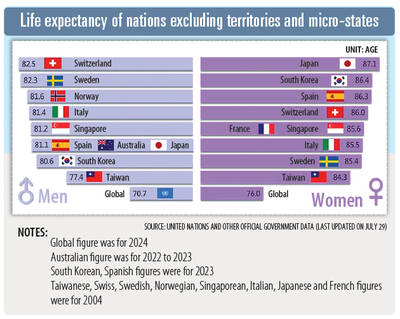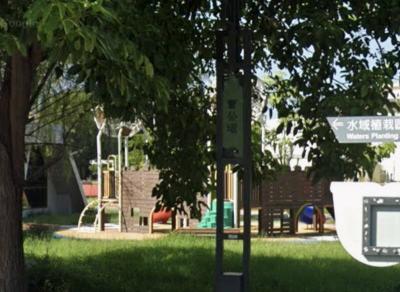To combat global warming and greenhouse gas emissions, developing renewable energy is the only way to reduce the exploitation of fossil fuel and phase out nuclear energy, visiting Potsdam Institute for Climate Impact Research director Hans Schellnhuber said that.
Schellnhuber, a joint recipient of the 2007 Nobel Peace Prize along with former US vice president Al Gore, made the remarks in two speeches in Taipei, on Thursday and yesterday.
During a symposium titled “Humanity at the Crossroads” in Taipei on Thursday, Schellnhuber said: “The debate of whether global warming is manmade is over. The question is what we do about it.”
The German researcher proposed the target of limiting global warming to no more than 2°C in 1995, which has been adopted by the German government and the EU and later as a target by governments worldwide.
However, he said that a majority of coral reefs would be lost if global temperatures rise by 1.5°C, which would also cause a slowdown in thermohaline circulation.
“If we burned all the fossil fuels of the planet, all the ice-sheets on the Atlantic Ocean would be melted, and sea levels would rise by 50m,” he said.
Comparing Taiwan with Germany, he said that both countries had depended on coal-fired energy to develop their heavy industry and electronics industry.
The development took its toll in Germany, producing smog and creating a retreating forest line in the Rhine-Ruhr area, after which the country was determined to transition to renewable energy, he said.
Germany aims to cut emissions by 40 percent by 2020 compared with 1990 levels, and phase out nuclear energy by 2022 after the Fukushima Dai-ichi nuclear disaster in 2011, he said, adding that Germany could serve as an example for Taiwan for how to successfully transition from coal-fired energy to renewable energy.
Schellnhuber added that although Germany’s carbon emissions rose when the nation started to decommission its nuclear power plants, the emissions later decreased when a renewable energy power grid was developed, and now the county’s power industry has a 50 percent oversupply.
That nuclear energy could guarantee the energy security is a misconception, and all we need is time to transition from nuclear and coal-fired energy to renewable energy, he said. Meanwhile, the Executive Yuan put forward an intended nationally determined contribution (INDC) on Thursday, specifying that Taiwan would reduce its greenhouse gas emissions by 50 percent by 2030.
Environmental Protection Administration (EPA) Minister Wei Kuo-yen (魏國彥) said the INDC was based on the scenario that three of the nation’s active nuclear plants would be decommissioned and the now-mothballed nuclear power plant be activated.
Separately, in a talk with Wei at the EPA headquarters in Taipei yesterday, Schellnhuber said it is very encouraging that Taiwan voluntarily proposed the INDC and the Greenhouse Gas Reduction Act (溫室氣體減量法) in June, adding that Taiwan is taking the global responsibility unilaterally, given that the county is not an official member of the UN or the Intergovernmental Panel on Climate Change.
However, Taiwan could make a difference by setting an example in the region and influencing China, which accounts for 23 percent of global carbon emissions, he said.
To reach the INDC goal, Taiwan could replace gas-powered scooters with electric models, develop offshore wind power and replace concrete with natural building materials, he said.

The inspection equipment and data transmission system for new robotic dogs that Taipei is planning to use for sidewalk patrols were developed by a Taiwanese company, the city’s New Construction Office said today, dismissing concerns that the China-made robots could pose a security risk. The city is bringing in smart robotic dogs to help with sidewalk inspections, Taipei Deputy Mayor Lee Ssu-chuan (李四川) said on Facebook. Equipped with a panoramic surveillance system, the robots would be able to automatically flag problems and easily navigate narrow sidewalks, making inspections faster and more accurate, Lee said. By collecting more accurate data, they would help Taipei

TAKING STOCK: The USMC is rebuilding a once-abandoned airfield in Palau to support large-scale ground operations as China’s missile range grows, Naval News reported The US Marine Corps (USMC) is considering new sites for stockpiling equipment in the West Pacific to harden military supply chains and enhance mobility across the Indo-Pacific region, US-based Naval News reported on Saturday. The proposed sites in Palau — one of Taiwan’s diplomatic allies — and Australia would enable a “rapid standup of stored equipment within a year” of the program’s approval, the report said, citing documents published by the USMC last month. In Palau, the service is rebuilding a formerly abandoned World War II-era airfield and establishing ancillary structures to support large-scale ground operations “as China’s missile range and magazine

STATS: Taiwan’s average life expectancy of 80.77 years was lower than that of Japan, Singapore and South Korea, but higher than in China, Malaysia and Indonesia Taiwan’s average life expectancy last year increased to 80.77 years, but was still not back to its pre-COVID-19 pandemic peak of 81.32 years in 2020, the Ministry of the Interior said yesterday. The average life expectancy last year increased the 0.54 years from 2023, the ministry said in a statement. For men and women, the average life expectancy last year was 77.42 years and 84.30 years respectively, up 0.48 years and 0.56 years from the previous year. Taiwan’s average life expectancy peaked at 81.32 years in 2020, as the nation was relatively unaffected by the pandemic that year. The metric

A 72-year-old man in Kaohsiung was sentenced to 40 days in jail after he was found having sex with a 67-year-old woman under a slide in a public park on Sunday afternoon. At 3pm on Sunday, a mother surnamed Liang (梁) was with her child at a neighborhood park when they found the man, surnamed Tsai (蔡), and woman, surnamed Huang (黃), underneath the slide. Liang took her child away from the scene, took photographs of the two and called the police, who arrived and arrested the couple. During questioning, Tsai told police that he had met Huang that day and offered to